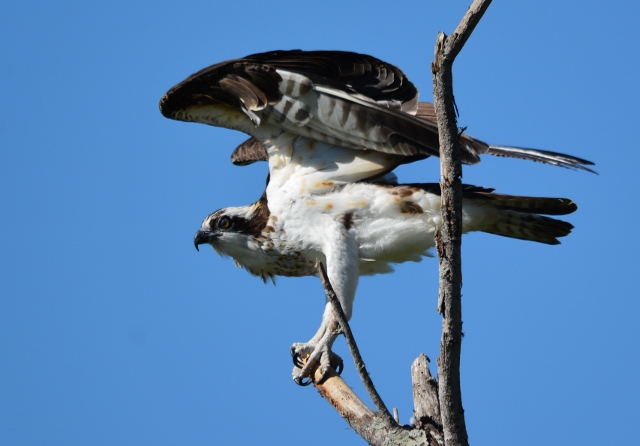Story and photos by Anita Westervelt, Texas Master Naturalist

Large kettles of vultures are a common sight in a Valley winter sky — black migrating vultures joining with our resident turkey vultures — a dozen or more in a kettle, circling up, up and away. Chances are they are searching for food although it could just be a fun outing swirling with the thermals high above the land. If they’re close enough to tell, turkey vultures show a tail when in flight; black vultures have a stubby tail. Turkey vultures are larger; their wingspan is about a foot longer –72 inches to a black vulture’s 60 inches. Vultures eat carrion. Turkey vultures find food while in flight, using their sense of smell; black vultures search exclusively by sight — and by watching where other vultures go.
Hawks are another winter visitor to watch for. They are likely to be spotted singly, perched on a utility pole or outer branches of trees. If flying, most likely they’re swooping to capture a prey. Hawks eat a wide variety of prey, from small to medium mammals, reptiles, crustaceans, grasshoppers, spiders, some fish and occasional small birds.
Two hawks easy to identify are red-shouldered hawks and red-tailed hawks. Red-shouldered hawks have a rich cinnamon-colored chest which tapers to rust-orange and white horizontal stripes. They have a black tail. Their wingspan is about 50 inches.

Red-tailed hawks, on the other hand, have a white belly with dark brown streaking; their tail varies from pale buff-pink to deep reddish-brown. They are of a similar size and perch lower than red-shouldered hawks.

A totally unique, large eagle-like hawk is now classified in a separate family: Osprey. It is a winter visitor in the Valley seen along the coastline, resacas and active irrigation ditches and other open waters where there is an abundant supply of fish, the raptor’s primary diet.

Osprey are a magnificent species with a powerful wingspan of six feet. In flight, an osprey might be mistaken for a red-tailed hawk at first glance but for its distinctive M-shaped flight form when seen from below. A closer look reveals almost pure-white undersides with a dusting of brown speckling at the throat and light-brown underwings. In birding parlance, the undersides of the wings show barring; the osprey’s barring is brown and white. The head is white with a brown top and a distinctive brown streak at each cheek.
Osprey are known to perch for hours overlooking water, head robotically pivoting from side to back to front and side — ever alert. It will flex its majestic wing feathers in preparation for flight, lift off and soar upwards and around, over the water with deep, slow wing beats alternating with glides. It might hover briefly, and if so, watch closely, the osprey is about to dive, then splash down feet first, often becoming completely submerged, to grab a fish in its long, hooked talons.
Once it captures its prey, the osprey rises like a phoenix, lumbering out of the water. It will have positioned the fish with its head forward to lessen aerodynamic drag as it flies to its perch. It captures fish as large as its own body.

